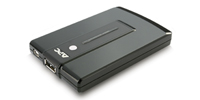APC as usual is pretty sparse on documentation for these sorts of things, so figured I’d point out it’s actually pretty simple.
Download
The first thing you’ll need to do is download the correct firmware. You’ll want the windows download. I’m serious. It should looks something like APC_SUMX_696_EN.zip.
Unpack
Unzip it and you’ll be left with a Windows executable (.exe) file. Open that with The Unarchiver which will leave you with a few files/directories:
NMCFirmwareUpdateUtility.exe edtFTPnetPRO.dll Bins
Upload
Ignore the first two. Inside Bins is are the 3 .bin files you really care about:
apc_hw05_sumx_696.bin
apc_hw05_bootmon_109.bin
apc_hw05_aos_696.bin
Now use your favorite FTP client and FTP into your UPS using the same user/password you use on the web UI. Upload bootmon first to the root directory. Wait for the system to restart (monitor ping or the web UI). Then upload aos and again wait for the system to restart. Once again with sumx (the application layer) and wait for the system to restart. Don’t change any filenames, don’t put them in directories.
If you don’t upload in this order it may crash on boot. Simply log back in via FTP and do it in this order to recover. Worst case if you may need to telnet in and hard reset things to defaults.
Uploads are slow since it’s FTP, so be patient. Reboots take 30 seconds or so.
Done. No Windows needed.
 Recently I ordered an APC USB Mobile Power Pack (
Recently I ordered an APC USB Mobile Power Pack (